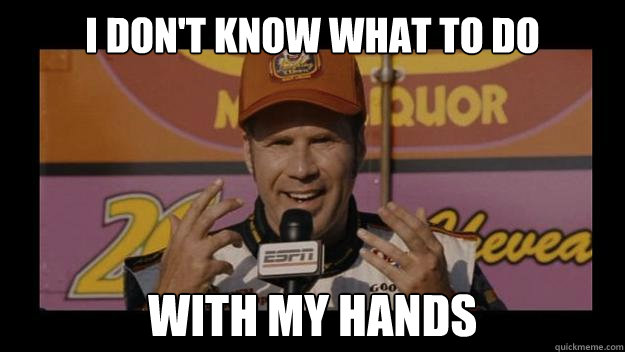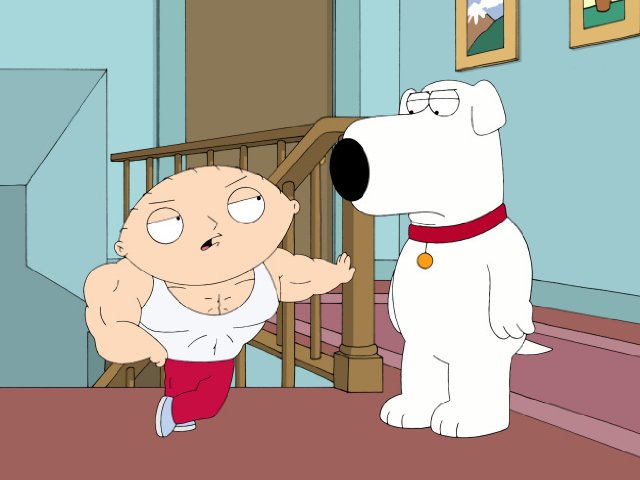Breaking in a New Bench Shirt
 This post is definitely a departure from SAPTstrength's usual fare (and essentially the antithesis to Stevo's Monday post). Not only are we diving headfirst into powerlifting preparation, but I'm talking about GEARED powerlifting!
For the uninitiated, geared powerlifting involves using very snug fitting "shirts" and "suits" (think the tightest compression shorts or shirts you can possibly imagine and multiply that by 100) to aide in the power lifts: squat, bench, and deadlift.
This post is definitely a departure from SAPTstrength's usual fare (and essentially the antithesis to Stevo's Monday post). Not only are we diving headfirst into powerlifting preparation, but I'm talking about GEARED powerlifting!
For the uninitiated, geared powerlifting involves using very snug fitting "shirts" and "suits" (think the tightest compression shorts or shirts you can possibly imagine and multiply that by 100) to aide in the power lifts: squat, bench, and deadlift.
So, what's the point of these aides? You can move more weight. Plain and simple. There is a huge cool-factor involved (read: ego-factor).
Up until this past summer, I had ONLY competed in geared events and I freaking loved it!
It is worth noting - and this cannot be UNDERstated - the training for geared powerlifting varies significantly from raw powerlifting. As you'll see in Sean's videos below, he has to work to simply get the bar down to his chest. He is literally having to PULL the bar down - hence why back work becomes so critical for the geared bencher. This can be very tough to imagine for someone who has never experienced a shirted bench.
Anyhow, my point here is not to convince you to be pro-gear. What I'd like to do is simply show an excellent progression to help learn the "groove" in a new bench shirt:
Sean starts his first set by touching a 3-board, the next set is to a 2-board, and the third set he is just able to touch his chest. This is a very intelligent way to learn to handle a new shirt. Some people get in them and simply pile on more and more weight until it finally touches their chest. Unfortunately, during this process they may never learn solid, safe, and effective form.
It is worth noting how well Sean is able to stay under control - you see very little, if any, breakdown in form: elbows stays tucked, chest stays up, and he is clearly actively pulling the bar down.
By the way, if you want to go to the true experts in powerlifting, you need to make your way over to EliteFTS.com and check out their training logs, the Q&A, and articles.
"Sort of Maxes": The Key to Dominating Competition and Longevity in Training
Just last week I posted a video of SAPT client, Lisa, nailing a 240lb deadlift on her "Test Day." Within a mere twenty-four hours of posting the video on my YouTube channel, someone commented the following: "good bar speed. i know your not powerlifiting but theres a few more pounds on the table so to speak. great strength and keep up the good work."
For those of you who haven't seen the video and don't know what he is talking about, here is the deadlift below:
As you can see, the YouTube commentator is exactly right! There are a few more pounds on the table. In fact, I'm willing to bet that Lisa could have pulled 260-265lbs (and perhaps a bit more) had she decided to "grind out" another max attempt. The 240lbs she pulled in the video was certainly not her true max, even though this was a freaking TESTING DAY for her.
And that is precisely the point.
I heard some advice from Dan John that couldn't have put into words a better description for what we do with our athletes and clients on a daily basis at SAPT, in order to facilitate continued strength and power development and reduce their risk of injury. In fact, it is something that everyone should do if they desire any hope of continuing to set PRs in the weight room and dominate the playing field:
"Go for a PR, single or rep, when you are feeling exceptionally strong, but stop short of an all-out max. Set a "sort of max."
This is the type of max you need to drive up. The "sort of max." Not your actual max. This is the key to safeguarding your body to remain fresh, injury free, and efficiently managing its stressors to continue to do what most of you reading are after: moving onward and upward, both in the gym and on the playing field.
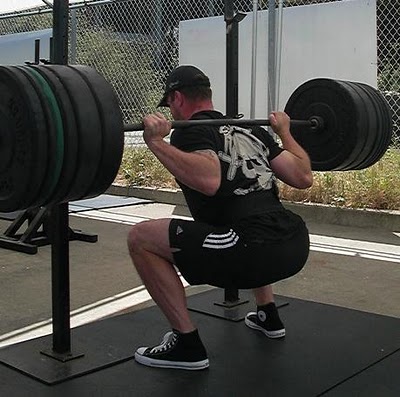 And yet, this is something that many seem to miss once we get all riled up in the weight room.
And yet, this is something that many seem to miss once we get all riled up in the weight room.
It's as if we lose all sense and wisdom once we get under that bar, in an effort to satisfy our ego more than the health of our spine.
In fact, this relates closely to what I personally believe sets the wise apart from the fool in this world: The degree of one's capacity to defer immediate satisfaction for the sake of a greater future reward.
This applies to all spheres of life, but, keeping within the context of strength training, the immediate satisfaction would be an extra 5-15lbs on a squat, bench, deadlift, or snatch attempt (the consequence often being stalling your progress, burning out, becoming injured, or feeling exhausted on game day). The greater future reward (in resisting urge the throw more weight on the bar) would be a healthy body, high performance levels, and continued PRs in the weight room.
It is telling that the great sprint coach, Charlie Francis, said the following as he was preparing Olympic sprinter Ben Johnson:
If there is any degradation in training, stop. If there is any doubt about one more rep or run, don't do it. If you are trying to learn with reps, you won't get it later if you haven't already. Leave it and come back to it.
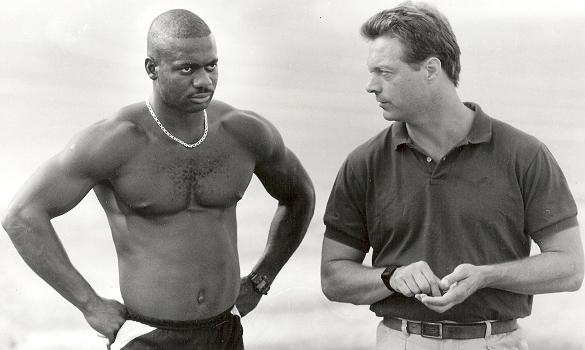 This is ESPECIALLY true when it comes to training athletes. It makes me sick to my stomach when I (frequently) hear of high school and college strength and conditioning coaches pushing the limits of their kids during each and every training session! It continues to blow my mind how many coaches don't have the most basic understanding of physiology and demands of the sport at hand in order to coach their athletes properly.
This is ESPECIALLY true when it comes to training athletes. It makes me sick to my stomach when I (frequently) hear of high school and college strength and conditioning coaches pushing the limits of their kids during each and every training session! It continues to blow my mind how many coaches don't have the most basic understanding of physiology and demands of the sport at hand in order to coach their athletes properly.
I conclude with two of Rif's famous corollaries:
- The next step off a peak is always down.
- One should step down rather than fall off.
Continue to push up your "sort of max" in the weight room. It's the best way to ensure continued growth and longevity in training. You'll thank me (and Dan John) later.
It All Starts With the Grip
I decided to give my on camera prowess a go today and talk about an awesome squat grip. It’s a thumbless, pinkyless grip that I’ve seen great results with. I learned this from a strength coach that I used to work under who currently trains at Tampa Barbell. I suggest giving this a shot if your shoulder and t-spine mobility is as bad as a T-Rex. Lay off me about my on camera ridiculousness; I felt like Ricky Bobby, wasn’t quite sure what to do with my hands. 
[vsw id="EsoWv6qwZ7c&feature=autoplay&list=UUKSYQ75Buogznl62rdbks2Q&lf=plcp&playnext=1" source="youtube" width="425" height="344" autoplay="no"]
On another note, I am preparing for my first geared (single-ply) meet in April. In all my other competitions I have competed raw and really had no idea how different lifting in gear would be. I got my bench shirt in the mail the other day and decided to try it out. Needless to say, it was rough. And after trying it out I don’t want to ever hear people say using gear is easier, it’s not. Out of all the things I’ve done in the weight room it was by far the hardest and most taxing. My bench shirt repeated yelled at me, “I PWN NOOBS”. Check out the video of my epic fail; couldn’t even get it to my chest.
[vsw id="0TQ5LNXlvMM&list=UUKSYQ75Buogznl62rdbks2Q&index=1&feature=plcp" source="youtube" width="425" height="344" autoplay="no"]
Press Around the Pain
If a bigger bench press is your goal there is a chance that at some point you will experience some type of elbow pain. This is usually brought on by the intensity, volume, or frequency at which you are bench pressing and most likely the combination of the three. What results is inflammation of the tendon near the olecranon. If left untreated the situation could become worse and result in tendinosis. When this problem comes about you have three options: You can take time off and let it recover, you can work through the pain, or you can find ways to work around the pain. Even though the smartest thing to do is take some time off, most people aren’t going to do this. Taking time off will reduce the stimulus to the area which will allow inflammation to subside and the area to heal.
Most people, including myself, are stubborn so if you refuse to take time off your next best option is working around the pain. This is what I did and I’m still making gains in my bench press while also reducing my elbow pain. The following are some of the ways I did that and I encourage you to implement them as well if you don't want to take the time off necessary to recover.
1. Take Out Elbow Dominant Accessory Work
Usually, what you’ll find, is that most elbow pain does not flare up during pressing exercises. Rather, the pain occurs during accessory movements that make the elbow the main point of action. Accessory movements such as triceps pushdowns, skull crushers, supine triceps extensions, and seated overhead triceps extensions should be avoided. These types of isolation exercises cause the elbows to take the brunt of the work and cause pain in already irritated elbows. Try substituting partial range of motion pressing movements, close grip pressing movements, or a combination of the two for your accessory movements. Things like a 4 board close grip bench press is a great one. As well as partial pushups to sandbags or to a 4-5 board works great as well. You’ll find that these movements will cause less elbow pain because the work is no longer completely centered on the elbow but spread out to the chest and shoulders.
[vsw id="8PA58Ds6duo&list=UUKSYQ75Buogznl62rdbks2Q&index=2&feature=plcp" source="youtube" width="425" height="344" autoplay="no"]
2. Hammer Your SMR and Mobility Work
When engaging in a high volume/high intensity press focused program, it is likely some serious adhesions will build up in your triceps. And if you’re not staying up on your shoulder and t-spine mobility, the problem in your elbows may get even worse. I learned these two lessons the hard way. Since making them a priority my elbows have gotten better, I still have a long way to go. Spend 5 minutes on your days off and after hard sessions rolling your triceps and anywhere around the problem area. I’ve found using the cardboard cylinder from the plastic wrap that athletic trainers use to wrap ice bags with to be an awesome tool to use for SMR. It’s small which allows for a little more concentrated roll and much more handy and easier to manipulate than an actual foam roller.
As I stated before it’s important to hammer your shoulder and t-spine mobility as well. Just like knee problems arise from poor hip mobility the same goes for elbow problems and lack of shoulder mobility. Poor shoulder mobility basically impedes the ability of the triceps to aid in shoulder extension and when coupled with excessive elbow dominant exercises the end result is inflammation and pain. Take time to work in some static stretching drills for your pecs, lats and rotator cuff. I found that working this in after your SMR sessions yields the best results. Be sure to also incorporate some t-spine extensions either on the wall or on a foam roller throughout your sessions as well in order to get that upper back a little more mobile. Try to accumulate around 5 minutes of total work for your shoulders and t-spine.
3. Use a Thorough Warm-up/Prehab work
In order to help work around your elbow pain, it’s imperative that the area have a good amount of blood flow before you slam it with heavy doubles or high volume accessory work. The same goes for your warm up and prehab work as it does for your accessory work; lay off the movements that isolate your elbow. Use full range pushups, band pullaparts, facepulls, rotator cuff circuits, etc. to warm up before pressing. These will not only get your elbows ready but also your upper back, shoulders and chest as well. One exercise I just recently started using that is a variation of an exercise I learned from Mark Bell is what I nicknamed the Elbow TKE. I’ve been using this almost every day for the past couple of weeks to warm up my elbows for not only pressing movements but for squatting, deadlifting, and just general blood flow work as well. This is an awesome exercise to isolate your triceps without putting direct pressure on the elbow.
[vsw id="OnqWOWq0WVA&feature=related" source="youtube" width="425" height="344" autoplay="no"]
Keep on pressing my friends.
10 Rules to Keep Your Man Card
In the short time I’ve been a strength coach I’ve learned a number of lessons from mentors and co-workers.; one of those lessons being how to lose your “man card”. It’s important for us to understand that our man card is not a right, but a privilege. And trust me, if you’re not careful yours will get snatched away! Hence the reason for writing this post; follow these simple rules and I promise your man card won’t be going anywhere. Rule 1: Do not wear your clothes so tight that your girlfriend mistakes them for hers. Guys, there’s no excuse for this, either buy some bigger clothes or get bigger yourself.
Rule 2: Do not comment on how vascular another man is/don’t talk about how vascular you are. Is this something I really need to explain? Just don’t do it, it’s weird.
Rule 3: If your 140lbs soaking wet do not talk about wanting to gain mass and then complain about not wanting to lose your “six-pack”. MAN UP! Start pounding whole milk and peanut butter and start MOVING WEIGHT!
Rule 4: Do not lip sync to your awful music in the mirror at the gym in between sets with an angry look on your face. When I was in college I saw this entirely too often. Let’s keep that nonsense to yourself guy in the tiny Affliction t-shirt and Euro Puma shoes.
Rule 5: Bringing this back to the beginning, do not wear skinny jeans so tight that your girlfriend asks if she can borrow them. Much to my dismay, I feel like this happens more than it ought to. As a matter of fact just don’t wear skinny jeans.
Rule 6: Do not begin every sentence with the word “Bro”. Usually the sentence that follows goes something like; “Bro, can I get a spot on these Preacher Curls?”
Rule 7: Do not lift your shirt up to check out your abs in the mirror while at the gym. Put your shirt down and get back to your Smith Machine quarter squats.
Rule 8: Do not use a foam pad on the barbell when squatting or front squatting. Again, MAN UP! Get used to the bar, get some bigger shoulders, and get a bigger yoke!
Rule 9: Do not update your status on Facebook to “gettin’ swole at the gym”. Newsflash, no one cares that you’re at the gym. Unless your status is “attempting a 600lbs deadlift today” we don’t want to hear about your adventures on the elliptical machine.
Rule 10: Do not be the guy five years out of high school at the local gym telling everyone about the glory days and how “strong” you used to be. This is what I like to call the Uncle Rico syndrome. It’s over man, move on. And chances are you weren’t as strong as you thought you were.
[vsw id="Fmh5e-9bn8w&feature=youtu.be" source="youtube" width="425" height="344" autoplay="no"]
I know what you’re saying to yourself, “Ryan, you’ve never been guilty of any of these things?” And my answer would be nope, not a one. Come on, you seriously think I’d admit to any of these things? Anyway, be sure to follow these rules in order to keep doing those manly things we like to do such as, chopping wood, going on river boat gambling trips, making beef jerky, hunting bears with our bare hands, and wearing flannel.
5 Quick & Random Training Tips
1. How and when you do your abdominal training in a given week is actually fairly important. For example, if you decide to do standing rollouts 24-48 hours before a heavy deadlift session, chances are your deadlifts are going to suffer greatly, and perhaps even be risky to attempt (it will be much more difficult to stabilize your lumbar spine).
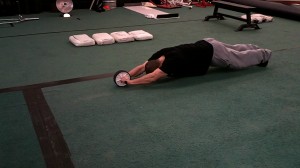 This is because rollout variations place incredible eccentric stress on the anterior core, inducing large amounts of soreness and requiring a longer recovery period. The only caveat to this rule would be if your name is Ross Enamait.
This is because rollout variations place incredible eccentric stress on the anterior core, inducing large amounts of soreness and requiring a longer recovery period. The only caveat to this rule would be if your name is Ross Enamait.
Other abdominal programming faux pas I can think of would be pairing an anterior loaded barbell variation (i.e. front squat or zercher grips) with an ab exercise, and/or placing a hanging leg raise before or alongside a farmers walk. The former is a blunder because anteriorly loaded barbell movements already place considerable demands on the core musculature; the latter isn't the greatest idea because your grip endurance is going to become an issue. Spread them apart to receive the maximum benefit of each.
2. If squatting is problematic for you, you don't need to force it. At least not initially. While the squat is a phenomenal movement and undoubtedly should be a staple in one's strength and conditioning program, I'm finding that more and more people need to earn the right to back squat safely, much like the overhead press. This may be due to structural changes (i.e. femoroacetabular impingement) or immobility (i.e. poor hip flexion ROM or awful glenohumeral external rotation and abduction).
If this is the case, simply performing a heavy single-leg movement as the first exercise in the session will work perfectly. You can use anything from forward lunges to bulgarian split squats, but my favorite is probably the barbell stepback lunge with a front squat grip.
You're still receiving the benefits of axial loading due to the bar position, you can still receive a healthy dose of compressive stress in your weekly training (if you're deadlifting), and yes, you'll still be exerting yourself. I recommend performing these in the 3-6 rep range to allow for appreciable loads.
And, keep in mind, when I said "if squatting is problematic" at the beginning of point #2, I was referring to structural, mobility, and/or stability abnormalities that may make it unsafe for you to squat for the time being. I wasn't, of course, implying that if it's "just too hard" that you shouldn't do it. There's a pretty thick line between one being contraindicated for an exercise and someone who's simply unwilling to to do a lift because it takes mental+physical exertion.
3. If your wrists bother you while doing pushups, try holding on to dumbbells. It will take your wrist out of an extended position into more of a neutral one, greatly reducing the stress on that joint.
 I also like holding on to dumbbells because they allow you to use a "neutral grip," thus externally rotating the humerus, giving your shoulder more room to breathe.
I also like holding on to dumbbells because they allow you to use a "neutral grip," thus externally rotating the humerus, giving your shoulder more room to breathe.
4. Think twice before consuming dairy as your pre-workout fuel. This may seem obvious, but frankly I still talk to people who consume cereal before a morning workout, or down milk shortly before an evening training session. Your stomach isn't going to like this while doing chest-supported T-Bar rows, anti-extension core variations, or anything for that matter.
Another tip: don't shove a bunch of doughnuts down your pie hole before training. I thought this one would be no-brainer, but I actually had a kid vomit after pushing the prowler at a sub-maximal intensity. Upon asking him what he ate beforehand, he said, "Umm, well nothing all day, and then I ate a bunch of doughnuts before coming here." Fail.
5. Figure out for yourself what training split is best for you personally. For example, I feel that training upper body the day before lower body affects me (negatively) more than if I do it the other way around. However, I know others who feel the exact opposite. Also, for those of you who utilize a bodypart split, and train deadlifts on "back day," be sure to take into consideration when and how you'll do squats on "leg day," due to the beating your spine will receive from both exercises.


